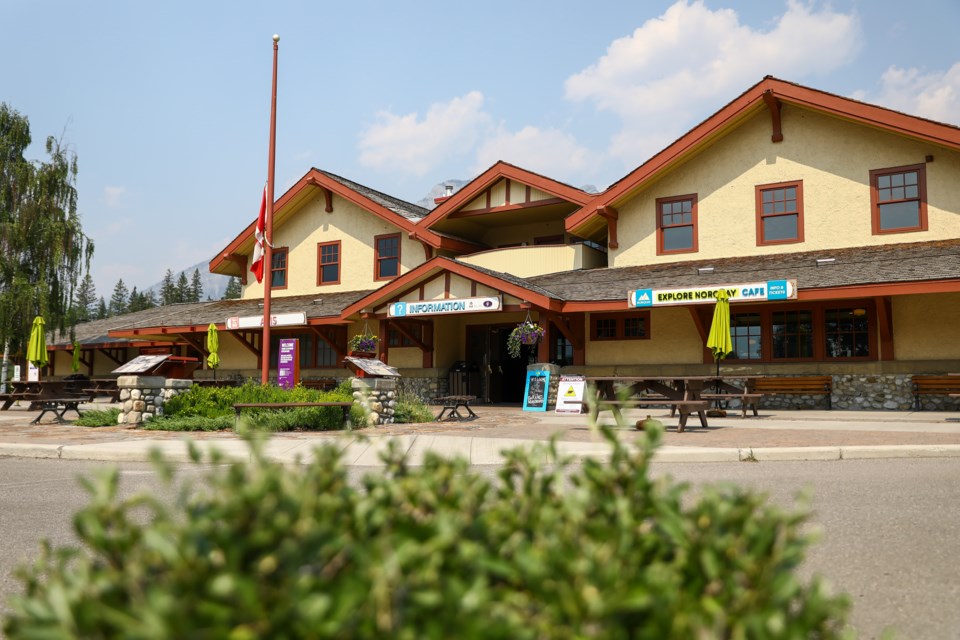BANFF – A draft area redevelopment plan for the train station lands in Banff has been submitted to Parks Canada for feedback.
The Town of Banff submitted Liricon Capital’s draft plan to the federal agency on Dec. 21. The draft plan paves the way for a potential gondola from the townsite to Mount Norquay and lays out the vision for a transit hub at the train station, which includes passenger rail from Calgary to Banff, among other proposals.
“I can accurately say that this is the most complex area redevelopment plan we’ve ever seen in the history of the Town of Banff,” said Darren Enns, the director of planning and development for the Town of Banff.
“I think the document you will see is one that will enable council to have a very informed discussion and debate around this policy proposal, so I am very eager to see that move through the process.”
Banff based-Liricon Capital holds the lease on the Canadian Pacific railway lands, which includes about 17.4 hectares on both the north and south sides of the tracks, and the 1910 train station, considered a federal heritage railway station.
Last year, a 16-page document covering highlights of redevelopment proposals indicated a transit hub centre would include free intercept parking, a shuttle centre, services that support passenger rail from Calgary to Banff, a rental centre for micro-transit and self-propelled transit, and eating and drinking establishments.
It also includes a residential district with medium-density housing and a proposal for a 300-seat amphitheatre next to the restored Canadian Pacific Railway gardens for concerts, festivals, aboriginal culture and special events.
The highlighted paper also included a terminus for an aerial gondola from the train station lands to the base of Mount Norquay ski hill, which Liricon’s managing partners Jan and Adam Waterous also own.
The 2010 management plan for Banff National Park called for exploring the feasibility of an aerial tramway system from the Banff townsite to the ski area to provide new visitor experiences while reducing human activity in the Cascade wildlife corridor. The draft management plan for Banff National Park is silent on the issue of a gondola.
In a letter to the Town of Banff on Aug. 20, 2021, Parks Canada indicated in no uncertain terms that an aerial gondola from the townsite to Mount Norquay flies in the face of existing federal legislation, policies and commercial development limits.
At the request of Liricon, a subsequent Sept. 10 letter from Parks clarified that any leaseholder has the right to submit a development proposal for changes to their lease. However, the agency indicated a gondola would be unlikely to get approval based on existing policies and legislation.
The federal agency is responsible for determining if the ARP conforms with federal statutes, including the Banff National Park Management Plan and Banff Incorporation Agreement, and deciding whether or not an environmental review of the ARP is required, and if so, determining the scope and level.
In August, Parks Canada asked to review the ARP ahead of it being released to the general public or public committees.
Justin Brisbane, a spokesperson for Banff National Park, said as the ARP pertains to land use and may have environmental impacts, Parks Canada will conduct a review to ensure it aligns with park policies and legislation, and to identify the scope of any required environmental review.
“The goal in doing so is to work collaboratively with the Town of Banff on an important endeavour and provide them with early feedback so the plan may be adjusted as required,” he said in a statement on Tuesday (Jan. 18).
After Parks Canada has reviewed the ARP, the process involves first reading to determine if council wants to move the proposal along any further. If it passes first reading, a public hearing will be called, followed by consideration of second and third reading for final consideration.
However, the federal minister of environment and climate change, whose portfolio includes Parks Canada, has final say on the ARP.
“Responsibility for environmental matters in the town and approval of land use bylaws – which would be the ultimate end point of the area redevelopment plan – rests with the minister responsible for Parks Canada,” said Brisbane.
Enns said he expects Parks Canada will give full feedback on the ARP by the end of February, setting the stage for first reading sometime in March.
“I would suggest we likely wouldn’t receive anything until deep February at best,” he said.
Just before the Town of Banff submitted the ARP to Parks Canada, Liricon Capital in partnership with Quebec-based Plenary Americas submitted an updated proposal to the provincial government to move the passenger rail proposal to the design phase.
The $1.5 billion proposal is to deliver a passenger train service from Calgary International Airport to downtown Calgary, and on to the mountains in Canmore and Banff by as early as 2025. The proposal seeks an Alberta government payment of $30 million per year for the project.
Jan Waterous said while the ARP for Banff’s train station lands includes passenger rail services, the ARP’s regulatory approval and public engagement process only relates to the railway lands and not to Calgary Airport-Banff Rail (CABR) itself.
“As CABR includes lands that are outside the Town of Banff, it will have its own separate regulatory approval and public engagement process separate from the ARP,” she said.
“Put another way, an approved ARP including passenger rail services is necessary but not sufficient for CABR’s potential ultimate approval.”
Waterous said the public will have two formal opportunities to comment on passenger rail from Calgary to Banff.
“First the public can comment on passenger rail services in the ARP, and second, the public can weigh in during CABR’s regulatory approval process,” she said.




